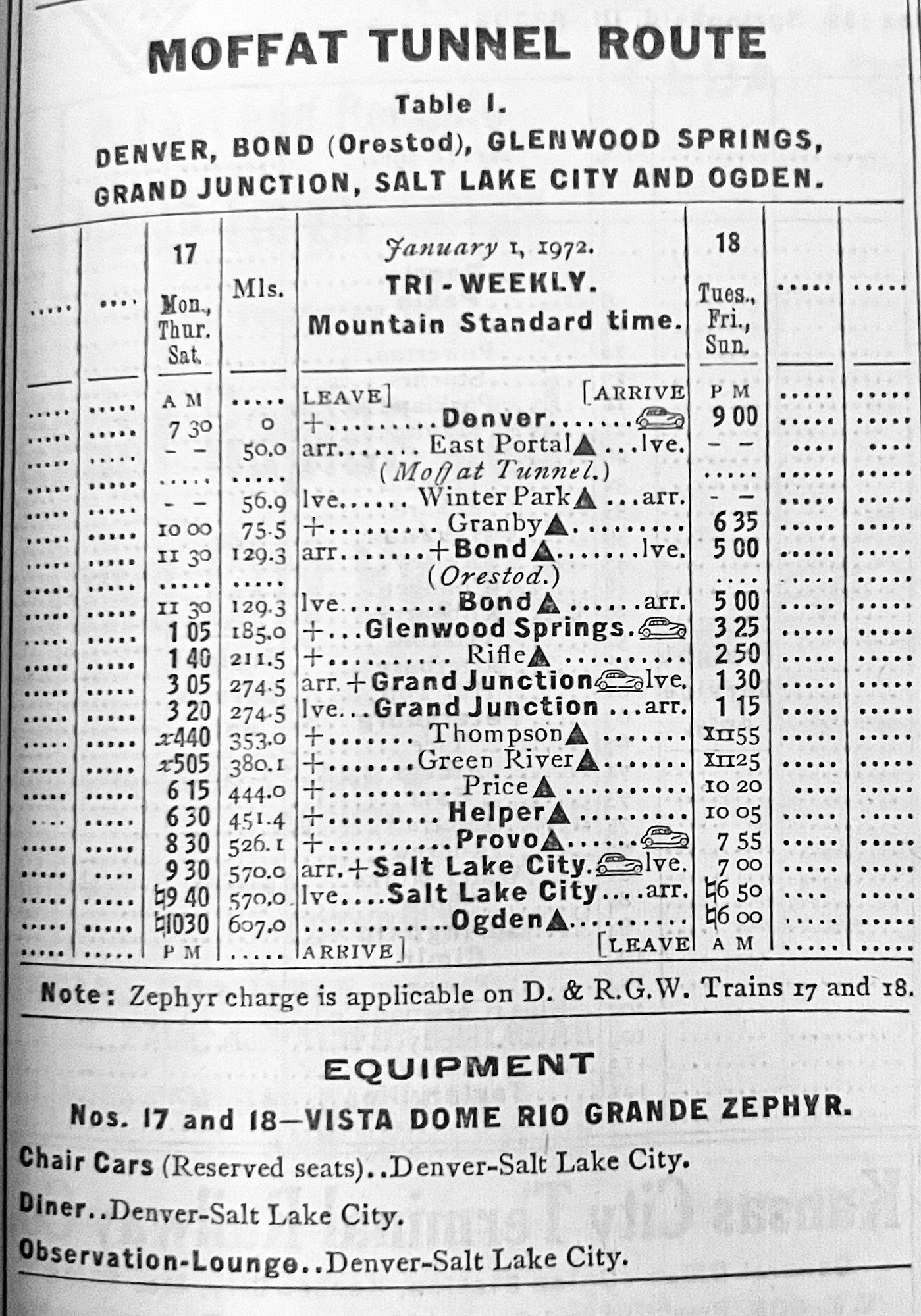"Rio Grande Zephyr" (Train): Consist, Timetable, History
Last revised: August 25, 2024
By: Adam Burns
Despite the California Zephyr's cancellation in March, 1970, ghosts of the train lingered for many years. While the Western Pacific had had enough with passenger service both the Burlington Northern and Rio Grande continued to host tri-weekly service, per Interstate Commerce Commission directive as the California Zephyr Service, or simply "California Service."
It was never a particularly popular train and always ran with only a few cars. When Amtrak began on May 1, 1971 the Rio Grande elected to continue hosting passenger service and did not join the national carrier.
It would introduce the Rio Grande Zephyr from Denver to Ogden. Interestingly, the RGZ, using former California Zephyr dome cars and equipment, enjoyed relatively strong ridership over part of its route through the late 1970s.
The RGZ, like the "California Service," was tri-weekly. It continued to operate privately for more than 12 years before the Rio Grande finally ended the train due rising costs and aging equipment.
Photos
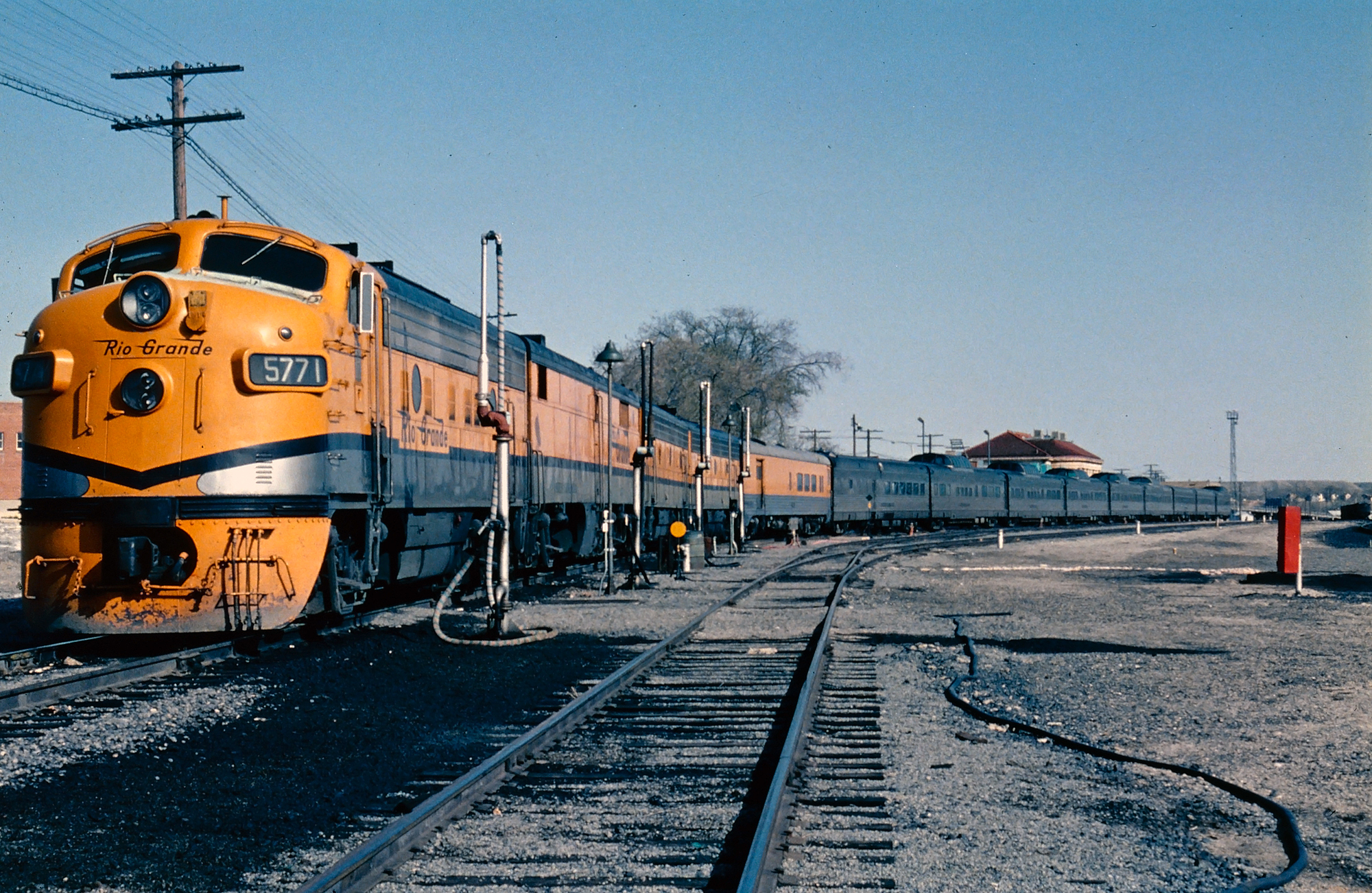 Rio Grande F9A #5771 leads one of the final runs of the "Rio Grande Zephyr" as the train is serviced at Grand Junction, Colorado in the early spring of 1983. Mike Bledsoe photo. American-Rails.com collection.
Rio Grande F9A #5771 leads one of the final runs of the "Rio Grande Zephyr" as the train is serviced at Grand Junction, Colorado in the early spring of 1983. Mike Bledsoe photo. American-Rails.com collection.History
On May 1, 1971 Amtrak began operations, a quasi-government entity that took over most intercity rail services across the country and largely relieved the private freight railroads from this money-losing burden.
However, for various reasons some roads elected not to join Amtrak and continued operating their own trains. The Rio Grande was one such renegade although its reasoning was largely financial in nature.
As a prerequisite to joining Amtrak, railroads were required to pay a fee equal to revenues lost on passenger operations in an average year.
They were also subject to annual incremental fees of operating the trains. It seems the Rio Grande felt the more economical route was to operate the RGZ itself and thus sidestepped Amtrak.
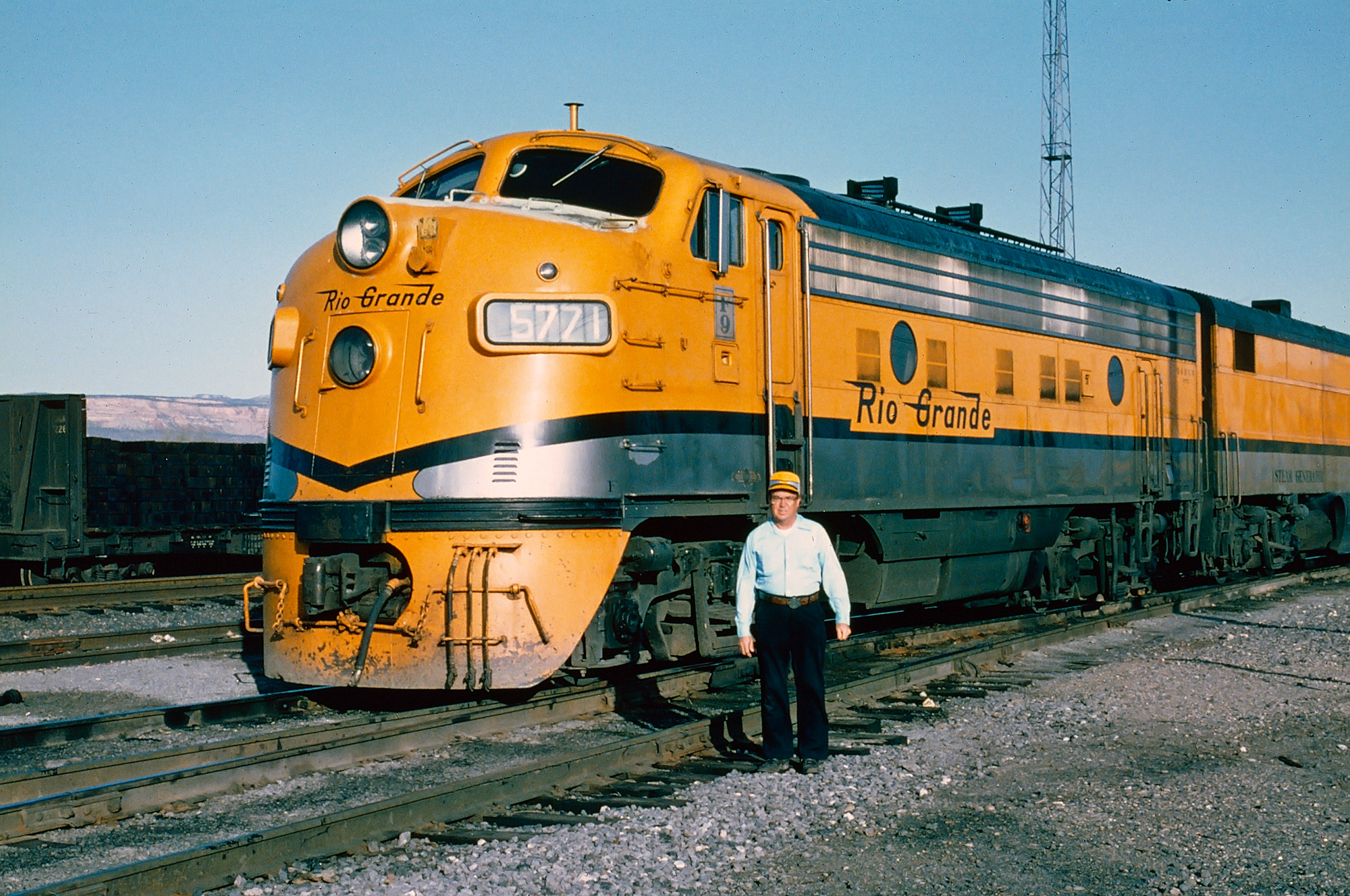 Mike Bledsoe (whose photography is featured throughout this website) poses in front of the "Rio Grande Zephyr" stopped at Grand Junction, Colorado in 1983. Dave Schumacher photo. American-Rails.com collection.
Mike Bledsoe (whose photography is featured throughout this website) poses in front of the "Rio Grande Zephyr" stopped at Grand Junction, Colorado in 1983. Dave Schumacher photo. American-Rails.com collection.Consist
EMD F9's (A-B or A-B-B)
Steam Generator Car (Ex-Alco PB-1)
Combine #1230/1231
Coach: Silver Aspen
Coach: Silver Pine
"Vista-Dome" Coach: Silver Bronco
"Vista-Dome" Chair Car: Silver Pony
"Vista-Dome" Chair Car: Silver Colt
"Vista-Dome" Chair Car: Silver Mustang
"Vista-Dome" Dormitory-Buffet-Lounge Car: Silver Shop
Diner (48 seats): Silver Banquet
"Vista-Dome" Buffet-Lounge-Observation: Silver Sky
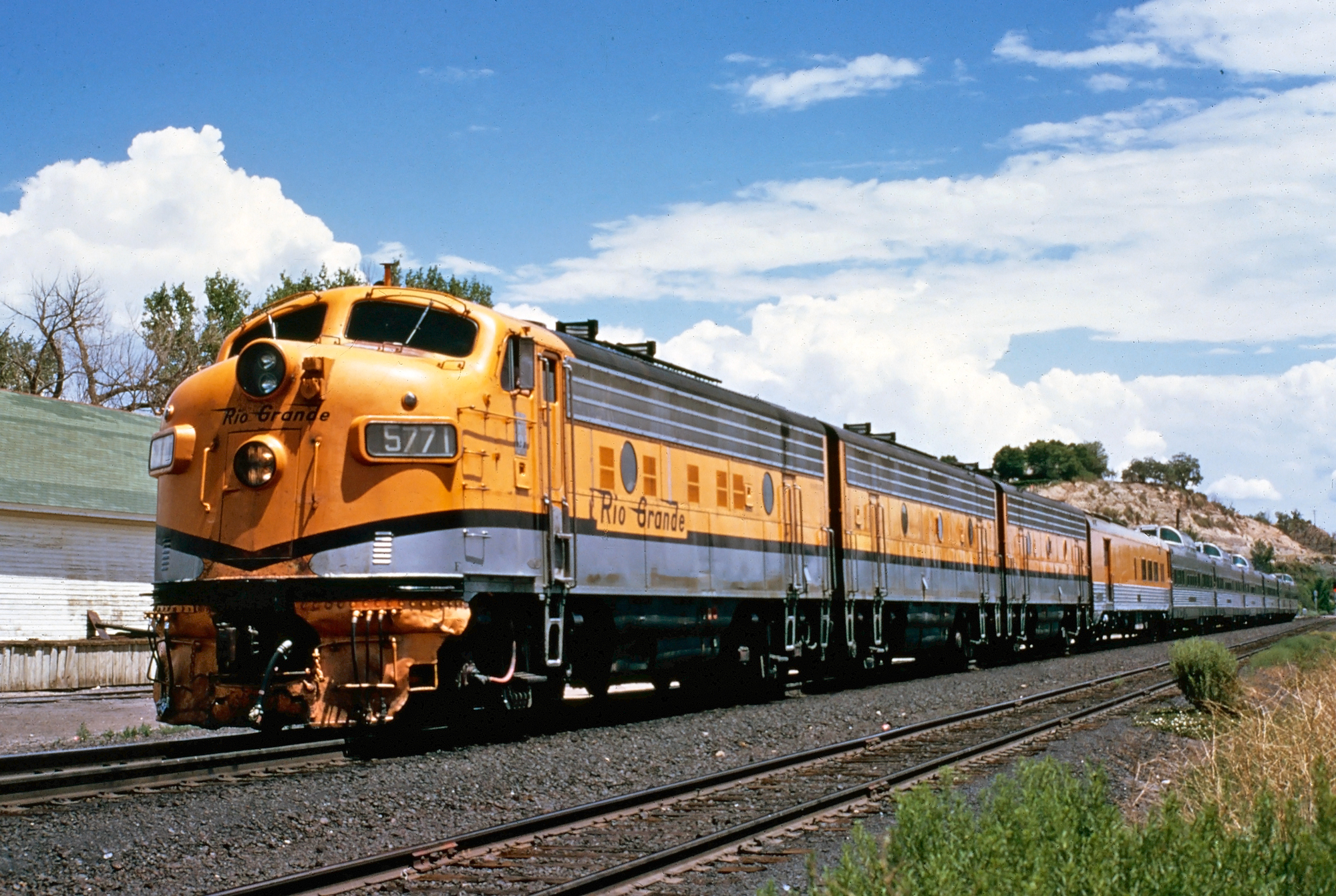 Rio Grande F9A #5771 leads the "Rio Grande Zephyr" at Rifle, Colorado circa 1975. Robert Eastwood Jr. photo. American-Rails.com collection.
Rio Grande F9A #5771 leads the "Rio Grande Zephyr" at Rifle, Colorado circa 1975. Robert Eastwood Jr. photo. American-Rails.com collection.At A Glance
15 Hours (Westbound) 15 Hours (Eastbound) |
|
17 (Westbound) 18 (Eastbound) | |
Union Station (Denver) Union Station (Ogden, Utah) |
In response, the national carrier launched its own version of the California Zephyr, which it called the San Francisco Zephyr. Unfortunately, the SFZ was neither as scenic nor offered the services of its predecessor (no domes and pre-heated/cooked meals were the norm).
It utilized the Burlington's main line as far as Denver but then turned north to Cheyenne via the Union Pacific until reaching Salt Lake City/Ogden. From this point the train ran on Southern Pacific trackage into the Bay Area.
Official Guide Listing (1972)
In an age when rail travel was looked upon as antiquated and outdated the Rio Grande Zephyr was a fine train. Its tri-weekly service continued to run with domes (some of which were converted from sleepers) and full-service dining was maintained for more than 12 years.
In his book, "Rio Grande Railroad," author James Griffin notes that at first the Rio Grande Zephyr was witnessed only light patronage. However, by the late 1970s the train ran mostly full between Denver and Glenwood Springs as Denver residents used the RGZ for overnight stays in the latter city.
While the train ran mostly empty west of Glenwood Springs it nevertheless was enjoying all-time high ridership by the early 1980s.
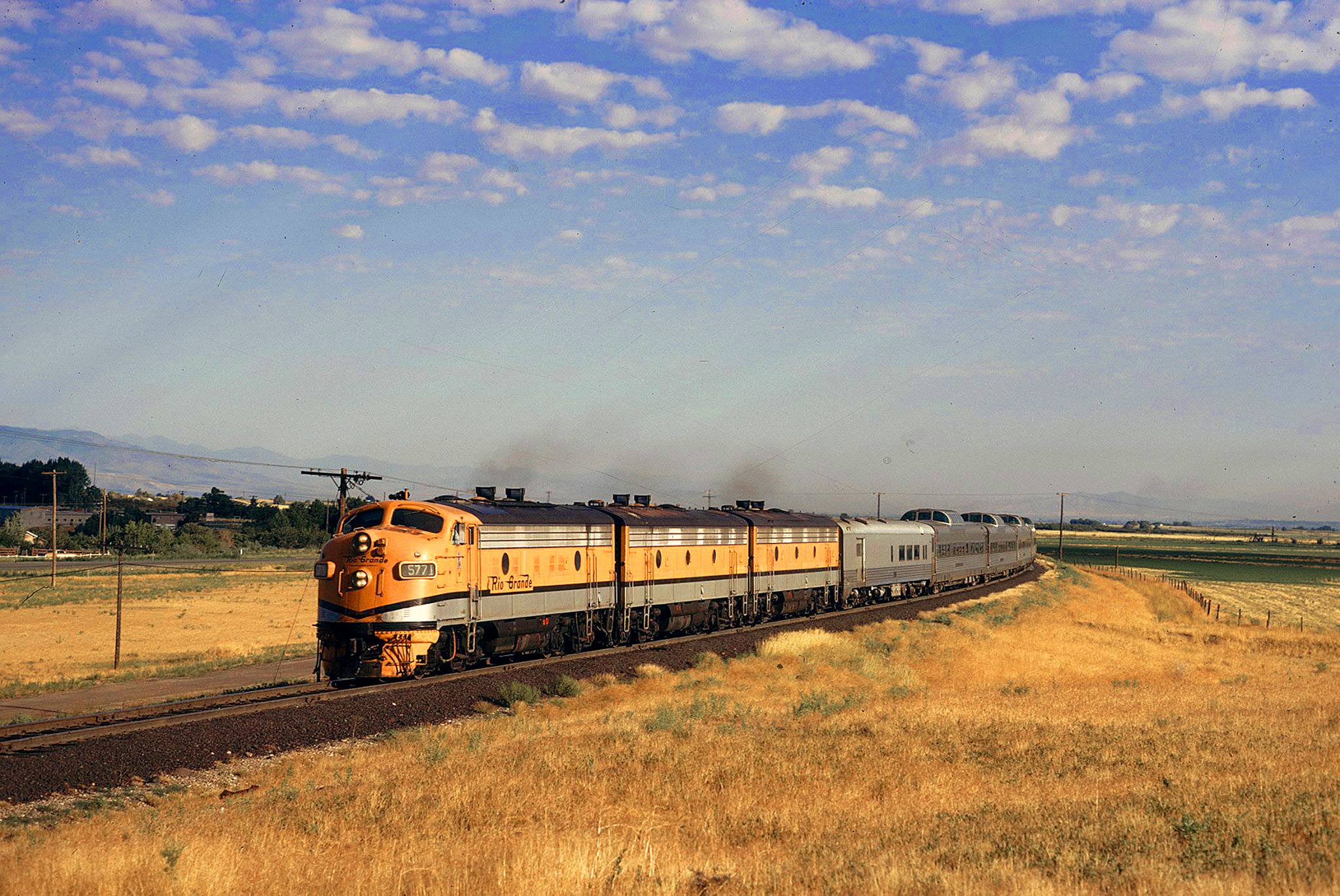 An A-B-B set of Rio Grande F9's hustle the eastbound "Rio Grande Zephyr" south of Spanish Fork, Utah, before its climb over Soldier Summit, during August of 1973. Drew Jacksich photo.
An A-B-B set of Rio Grande F9's hustle the eastbound "Rio Grande Zephyr" south of Spanish Fork, Utah, before its climb over Soldier Summit, during August of 1973. Drew Jacksich photo.Final Years
Alas, with a difficult decision as operating and labor costs continued to climb the Rio Grande eventually understood the logical and obvious choice to hand over the country's last privately operated passenger train to Amtrak.
In a New York Times article entitled "Rail Buffs Bid Adieu To Rio Grande Zephyr" by William Schmidt published on April 24, 1983 the paper covered its final run west from Denver on April 23rd. The engineer that day was John Schoening whose train was packed with 375 passengers with tickets having sold out weeks in advance.
Timetable (January 1, 1972)
Tri-Weekly
| Time/Read Down (Train #17) | Milepost | Time/Read Up (Train #18) | |
|---|---|---|---|
| 7:30 AM (Depart) | 0.0 | 9:00 PM (Arrive) | |
| 50.0 | |||
| 56.9 | |||
| 10:00 AM | 75.5 | 6:35 PM | |
| 11:30 AM | 129.3 | 5:00 PM | |
| 1:05 PM | 185.0 | 3:25 PM | |
| 1:40 PM | 211.5 | 2:50 PM | |
| 3:05 PM (Arrive) | 274.5 | 1:30 PM (Depart) | |
| 3:20 PM (Depart) | 274.5 | 1:15 PM (Arrive) | |
| 4:40 PM | 353.0 | 11:55 AM | |
| 5:05 PM | 380.1 | 11:25 AM | |
| 6:15 PM | 444.0 | 10:20 AM | |
| 6:30 PM | 451.4 | 10:05 AM | |
| 8:30 PM | 526.1 | 7:55 AM | |
| 9:30 PM (Arrive) | 570.0 | 7:00 AM (Depart) | |
| 9:40 PM (Depart) | 570.0 | 6:50 AM (Arrive) | |
| 10:30 PM (Arrive) | 607.0 | 6:00 AM (Depart) |
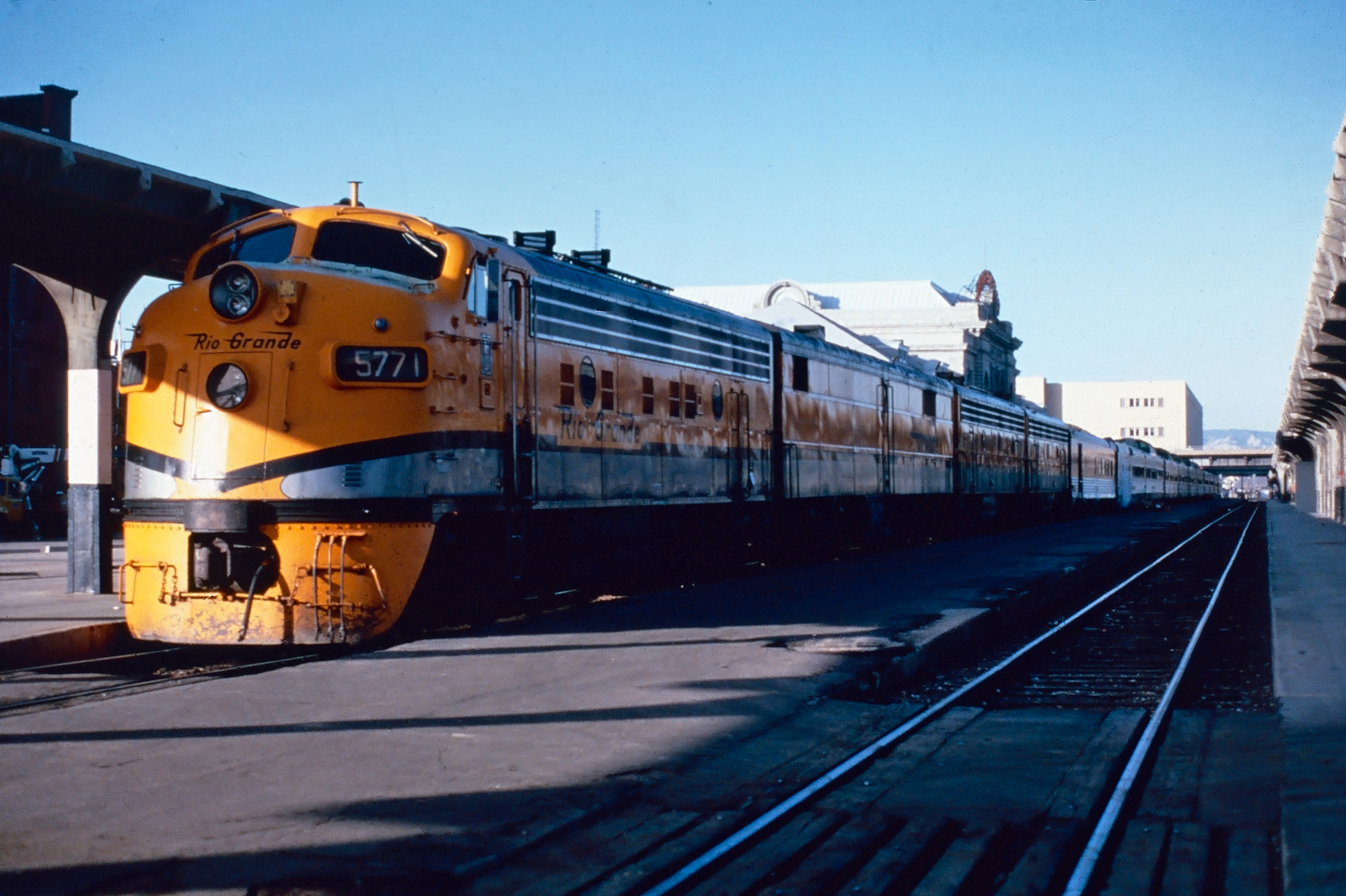 Rio Grande F9A #5771 at Denver Union Station with the "Rio Grande Zephyr," circa 1975. Robert Eastwood, Jr. photo. American-Rails.com collection.
Rio Grande F9A #5771 at Denver Union Station with the "Rio Grande Zephyr," circa 1975. Robert Eastwood, Jr. photo. American-Rails.com collection.It left Denver Union Station at 7:30 AM and made history as not only the final privately operated passenger train but also the last to offer full-service dining, an amenity which has never returned to this day.
The Times article quoted Rio Grande's director of passenger and dining car services at the time, Leonard Bernstein, who stated, "I've obviously got mixed emotions but I'm looking forward to Amtrak taking over the route. I think their service is getting better all the time."
Considering the carrier's chronic lack of on-aboard accommodations since then some will likely disagree with his assessment. After the RGZ's last run, Amtrak reinstated the California Zephyr name and, after a delay due to a mudslide, returned its routing via Rio Grande trackage on July 16th that year.
Sources
- Griffin, James R. Rio Grande Railroad. St. Paul: Voyageur Press, 2003.
- Laidlaw, R.J. (Manager), Coyle, F. (Assistant Manager). Official Guide Of The Railways And Steam Navigation Lines Of The United States, Porto Rico, Canada, Mexico, and Cuba, The. Volume 104. Issue 12. Page 309. New York: National Railway Publication Company, 1972.
- Schafer, Mike and Welsh, Joe. Streamliners, History of a Railroad Icon. St. Paul: MBI Publishing, 2003.
Recent Articles
-
Indiana's Dinner Train Rides In Jasper!
Jan 18, 26 01:54 PM
In the rolling hills of southern Indiana, the Spirit of Jasper offers one of those rare attractions that feels equal parts throwback and treat-yourself night out: a classic excursion train paired with… -
New Mexico's Dinner Train Rides
Jan 18, 26 01:37 PM
If your heart is set on clinking glasses while the desert glows at sunset, you can absolutely do that here—just know which operator offers what, and plan accordingly. -
New Hampshire ~ Murder Mystery ~ Dinner Train Rides
Jan 18, 26 01:10 PM
The state's murder mystery trains stand out as a captivating blend of theatrical drama, exquisite dining, and scenic rail travel. -
New York Valentine's Train Rides
Jan 18, 26 12:32 PM
At its best, the Adirondack Railroad delivers exactly what railfans and casual riders alike hope for: vintage coaches, classic depots, rivers and forests right outside the window. -
Washington Valentine's Train Rides
Jan 18, 26 10:50 AM
Whether you’re a dedicated railfan chasing preserved equipment or a couple looking for a memorable night out, CCR&M offers a “small railroad, big experience” vibe—one that shines brightest on its spec… -
Colorado Valentine's Train Rides
Jan 18, 26 10:49 AM
The Royal Gorge Route Railroad is the kind of trip that feels tailor-made for railfans and casual travelers alike, including during Valentine's weekend. -
Georgia Valentine's Train Rides
Jan 18, 26 10:42 AM
f you’ve ridden the SAM Shortline, it’s easy to think of it purely as a modern-day pleasure train—vintage cars, wide South Georgia skies, and a relaxed pace that feels worlds away from interstates and… -
New Jersey ~ Murder Mystery ~ Dinner Train Rides
Jan 17, 26 01:16 PM
There are currently no murder mystery dinner trains available in New Jersey although until 2023 the Cape May Seashore Lines offered this event. Perhaps they will again soon! -
West Virginia Dinner Train Rides In Elkins!
Jan 17, 26 01:08 PM
The D&GV offers the kind of rail experience that feels purpose-built for railfans and casual travelers. -
Virginia Dinner Train Rides In Staunton!
Jan 17, 26 11:55 AM
If you’ve ever wished you could pair a classic scenic train ride with a genuinely satisfying meal—served at your table while the countryside rolls by—the Virginia Scenic Railway was built for you. -
Florida Easter Train Rides
Jan 17, 26 10:23 AM
The cold weather rarely invades Florida and the state nearly always warm and balmy early spring temperatures. Learn more about where you can find Easter-themed train rides across the Sunshine State. -
Ohio Easter Train Rides
Jan 17, 26 10:13 AM
Ohio is home to several museums and excursion trains preserving the state's rich railroading heritage. A few of these locations host Easter-themed train rides each spring. -
Massachusetts Valentine's Train Rides
Jan 17, 26 09:58 AM
The Cape Cod Central Railroad (CCCR) blends classic New England scenery with heritage equipment, narrated sightseeing, and some of the region’s best-known “rails-and-meals” experiences. -
California Valentine's Train Rides
Jan 17, 26 09:53 AM
Operating out of West Sacramento, this excursion railroad has built a calendar that blends scenery with experiences—wine pours, themed parties, dinner-and-entertainment outings, and seasonal specials… -
South Carolina Dinner Train Rides
Jan 16, 26 11:13 PM
There is only location in the Palmetto State offering a true dinner train experience can be found at the South Carolina Railroad Museum. Learn more here. -
Rhode Island Dinner Train Rides
Jan 16, 26 11:01 PM
Despite its small size, Rhode Island is home to one popular dinner train experience where guests can enjoy the breathtaking views of Aquidneck Island. -
Pennsylvania's Thomas The Train Rides
Jan 16, 26 04:13 PM
"A Day Out With Thomas” train rides offer a unique opportunity for children and their families to engage in a magical and memorable experience, setting the stage for a full day of fun and adventure. -
Illinois's Thomas The Train Rides
Jan 16, 26 02:23 PM
In Illinois, the "A Day Out With Thomas" event offers a unique chance for families to immerse themselves in the enchanting world of Thomas and friends, creating memories that last a lifetime. -
New Jersey's Thomas The Train Rides
Jan 16, 26 02:11 PM
Here's a comprehensive guide to what you can expect at Day Out With Thomas events in New Jersey. -
Texas ~ Murder Mystery ~ Dinner Train Rides
Jan 16, 26 01:54 PM
Here’s a comprehensive look into the world of murder mystery dinner trains in Texas. -
Connecticut ~ Murder Mystery ~ Dinner Train Rides
Jan 16, 26 01:26 PM
All aboard the intrigue express! One location in Connecticut typically offers a unique and thrilling experience for both locals and visitors alike, murder mystery trains. -
New Hampshire Dinner Train Rides In N. Conway!
Jan 16, 26 10:47 AM
Tucked into the heart of New Hampshire’s Mount Washington Valley, the Conway Scenic Railroad is one of New England’s most beloved heritage railways -
Oregon Dinner Train Rides Near Mt. Hood!
Jan 16, 26 10:44 AM
The Mt. Hood Railroad is the moving part of that postcard—a century-old short line that began as a working railroad. -
Maryland's - Wine Tasting - Train Rides
Jan 15, 26 02:59 PM
This article delves into the enchanting world of wine tasting train experiences in Maryland, providing a detailed exploration of their offerings, history, and allure. -
Colorado's - Wine Tasting - Train Rides
Jan 15, 26 02:46 PM
To truly savor these local flavors while soaking in the scenic beauty of Colorado, the concept of wine tasting trains has emerged, offering both locals and tourists a luxurious and immersive indulgenc… -
Iowa ~ Wine Tasting ~ Train Rides
Jan 15, 26 02:36 PM
The state not only boasts a burgeoning wine industry but also offers unique experiences such as wine by rail aboard the Boone & Scenic Valley Railroad. -
Georgia's Wine Train Rides In Cordele!
Jan 15, 26 02:26 PM
While the railroad offers a range of themed trips throughout the year, one of its most crowd-pleasing special events is the Wine & Cheese Train—a short, scenic round trip designed to feel like a t… -
Indiana ~ Murder Mystery ~ Dinner Train Rides
Jan 15, 26 02:22 PM
This piece explores the allure of murder mystery trains and why they are becoming a must-try experience for enthusiasts and casual travelers alike. -
Ohio ~ Murder Mystery ~ Dinner Train Rides
Jan 15, 26 02:10 PM
The murder mystery dinner train rides in Ohio provide an immersive experience that combines fine dining, an engaging narrative, and the beauty of Ohio's landscapes. -
Nevada Dinner Train Rides In Ely!
Jan 15, 26 02:01 PM
If you’ve ever wished you could step through a time portal into the hard-working world of a 1900s short line the Nevada Northern Railway in Ely is about as close as it gets. -
Michigan Dinner Train Rides In Owosso!
Jan 15, 26 09:46 AM
The Steam Railroading Institute is best known as the home of Pere Marquette #1225 and even occasionally hosts a dinner train! -
Arizona's - Wine Tasting - Train Rides
Jan 14, 26 02:04 PM
For those who want to experience the charm of Arizona's wine scene while embracing the romance of rail travel, wine tasting train rides offer a memorable journey through the state's picturesque landsc… -
Arkansas's - Wine Tasting - Train Rides
Jan 14, 26 01:57 PM
This article takes you through the experience of wine tasting train rides in Arkansas, highlighting their offerings, routes, and the delightful blend of history, scenery, and flavor that makes them so… -
Tennessee ~ Murder Mystery ~ Dinner Train Rides
Jan 14, 26 01:42 PM
Amidst the rolling hills and scenic landscapes of Tennessee, an exhilarating and interactive experience awaits those with a taste for mystery and intrigue. -
California ~ Murder Mystery ~ Dinner Train Rides
Jan 14, 26 01:26 PM
When it comes to experiencing the allure of crime-solving sprinkled with delicious dining, California's murder mystery dinner train rides have carved a niche for themselves among both locals and touri… -
Illinois ~ Murder Mystery ~ Dinner Train Rides
Jan 14, 26 01:13 PM
Among Illinois's scenic train rides, one of the most unique and captivating experiences is the murder mystery excursion. -
Vermont's - Murder Mystery - Dinner Train Rides
Jan 14, 26 12:57 PM
There are currently murder mystery dinner trains offered in Vermont but until recently the Champlain Valley Dinner Train offered such a trip! -
Massachusetts Dinner Train Rides On Cape Cod!
Jan 14, 26 12:20 PM
The Cape Cod Central Railroad (CCCR) has carved out a special niche by pairing classic New England scenery with old-school hospitality, including some of the best-known dining train experiences in the… -
Maine Dinner Train Rides In Portland!
Jan 14, 26 11:31 AM
While this isn’t generally a “dinner train” railroad in the traditional sense—no multi-course meal served en route—Maine Narrow Gauge does offer several popular ride experiences where food and drink a… -
Kentucky Dinner Train Rides In Bardstown!
Jan 13, 26 01:14 PM
The essence of My Old Kentucky Dinner Train is part restaurant, part scenic excursion, and part living piece of Kentucky rail history. -
Kansas Dinner Train Rides In Abilene!
Jan 13, 26 12:44 PM
If you’re looking for a heritage railroad that feels authentically Kansas—equal parts prairie scenery, small-town history, and hands-on railroading—the Abilene & Smoky Valley Railroad (A&SV) delivers. -
Michigan ~ Murder Mystery ~ Dinner Train Rides
Jan 13, 26 11:24 AM
Among the lesser-known treasures of this state are the intriguing murder mystery dinner train rides—a perfect blend of suspense, dining, and scenic exploration. -
Virginia's - Murder Mystery - Dinner Train Rides
Jan 13, 26 11:11 AM
Among the state's railroad attractions, murder mystery dinner trains stand out as a captivating fusion of theatrical entertainment, fine dining, and scenic travel. -
Arizona Dinner Train Rides At The Grand Canyon!
Jan 13, 26 10:59 AM
While the Grand Canyon Railway does not offer a true, onboard dinner train experience it does offer several upscale options and off-train dining. -
Georgia Dinner Train Rides In Nashville!
Jan 13, 26 10:27 AM
If you’ve ever wished you could slow down, trade traffic for jointed rail, and let a small-town landscape roll by your window while a hot meal is served at your table, the Azalea Sprinter delivers tha… -
Indiana Valentine's Train Rides
Jan 12, 26 04:27 PM
If you’ve ever wished you could step into a time when passenger trains were a Saturday-night treat and a whistle echoing across farm fields meant “adventure,” the Nickel Plate Express delivers that fe… -
Ohio Valentine's Train Rides!
Jan 12, 26 04:20 PM
The Hocking Valley Scenic Railway offers one of the region’s most atmospheric ways to experience the Hocking Hills area: from the rhythmic click of jointed rail to the glow of vintage coaches rolling… -
Wisconsin's - Wine Tasting - Train Rides
Jan 12, 26 03:10 PM
Wisconsin might not be the first state that comes to mind when one thinks of wine, but this scenic region is increasingly gaining recognition for its unique offerings in viticulture. -
California's - Wine Tasting - Train Rides
Jan 12, 26 02:34 PM
This article explores the charm, routes, and offerings of these unique wine tasting trains that traverse California’s picturesque landscapes. -
Wisconsin Scenic Train Rides In North Freedom!
Jan 12, 26 02:20 PM
The Mid-Continent Railway Museum is a living-history museum built around the sights, sounds, and everyday rhythms of small-town and shortline railroading in the early 20th century, what the museum cal…

